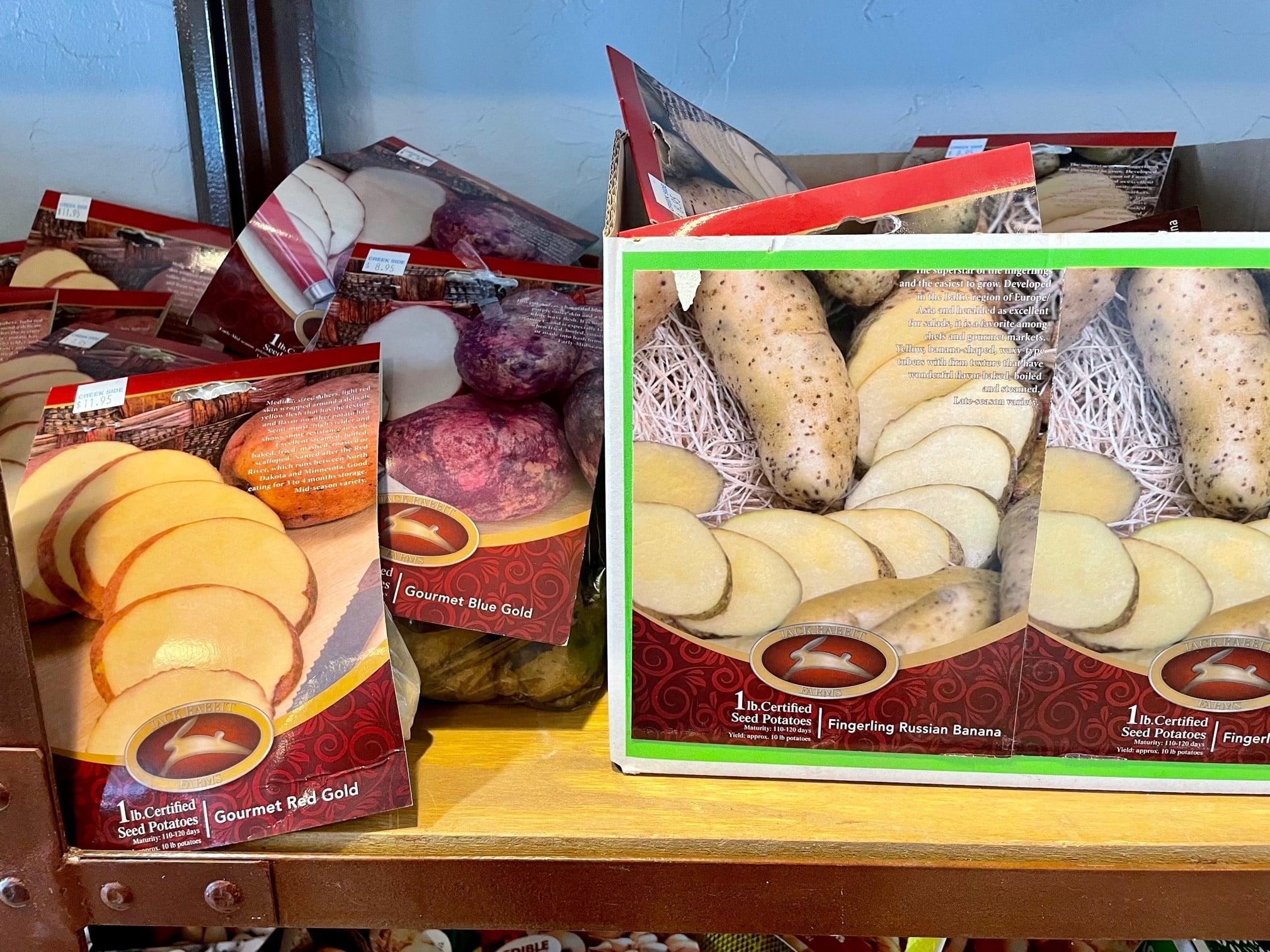Growing Potatoes at Home
Growing Tips:
Seed potatoes aren’t really seeds at all. They are full-size potatoes that are allowed to start producing shoots in the potato eyes. You’ve probably seen this happen when you’ve stored potatoes in the kitchen for too long.
Seed potatoes can be planted whole or cut into pieces, with each piece containing an eye or two (or three). Because potatoes can rot if the soil is too cool or wet, many gardeners prefer to allow the cut pieces to callus over, by leaving them exposed overnight. You can also purchase a powdered fungicide for dusting onto the pieces, to avoid rotting.
Cold climate gardeners plant potatoes in mid to late spring. Warm climates do best planting in either late summer or late winter, so the plants aren’t trying to grow during the hottest months.
How to Plant:
Choose a sunny spot with well-draining, loose soil, so that the roots and tubers can develop.
Trench Method: A traditional potato planting method involves digging a shallow trench, about 6 inches deep and placing the seed potatoes in the trench, eyes facing up. Then cover the potatoes with a couple of inches of soil. As the potato plant grows, soil is continually hilled up along the sides of the plants. This keeps the soil around the developing tubers loose and keeps the surface tubers from being exposed to sunlight, which will turn them green and somewhat toxic. Hill soil whenever the plants reach about 4-6 inches in height. You can stop tilling when the plants begin to flower.
Scatter Method: Some gardeners prefer to simply lay the seed potatoes right on the soil and then cover them with a few inches of mulch. You can continue laying mulch as the plants grow. If you have a rodent problem, this method is probably not your best choice.
Container Method: The container method makes hilling easy and takes up less space. Plant your seed potatoes in the bottom of a tall container, like a clean garbage can or whiskey barrel. Put about 6 inches of soil in the bottom first, then spread out your seed potatoes. Keep adding soil as the plants get taller. I’ve tried this several times using just a bale of peat and it worked quite well. Maintenance: Potatoes don’t like particularly rich soil. If you have a good amount of organic matter in the soil and the pH is good, the potatoes should be happy. What they do r
Other Cool Season Vegetable Bulbs
Asparagus crowns – Asparagus grows best in deep, well-drained sandy loam soil. Improve Colorado soils with organic matter like compost to increase drainage. Make a trench 8“deep, in rows 4’ apart. The asparagus crowns are then laid in the trench 8-12” apart. Cover the crowns with 2-3” of soil. Some spears may be harvested the first year on a limited basis. Each year your harvest will increase. Full harvest will be reached in 4-6 years.
Garlic bulbs – Garlic performs best when planted in a light, sandy soil that has been amended with compost. Plant in early spring when the ground has warmed to 50 degrees. Dig a hole 3-4” deep. Break bulbs up into individual cloves, set firmly in place with pointed ends up. Allow soil to dry between watering. Harvest mid-late summer.
Onion bulbs – Plant in well-drained soil that has been loosened. Plant apart in rows and only deep enough so that the tops of the bulb sets are covered with soil. Harvest at end of season when fully mature and air dry.
Rhubarb – Prepare the soil by incorporating a good garden fertilizer. Plant the crowns 3-4” below the surface with the crown bud about 2” below the soil. Space the crowns 1.5-2’ apart. Do not harvest the first year. This will allow the plant to send its energy and nutrients back to the roots to ensure a strong root system. Do not remove more than one half of the stalks when harvesting.
Cool Season Flowers
Pansies – Creek Side has a beautiful Grown Fresh™ batch blooming in 6-paks and ready for planting now! Our pansy bowls and pots will be ready to go in another couple of weeks. In addition to pansies, consider snapdragons, dianthus, alyssum, and dusty miller. Creek Side will have these plants ready by early April.
Perennials – A Creek Side specialty, our Grown Fresh™ perennial crop is really looking great this year. Over 350 varieties this year including many Plant Select varieties, which have been specifically chosen for our climate. Our growing experts are getting them ready for you by turning the temperatures down, so they are conditioned for your garden.

